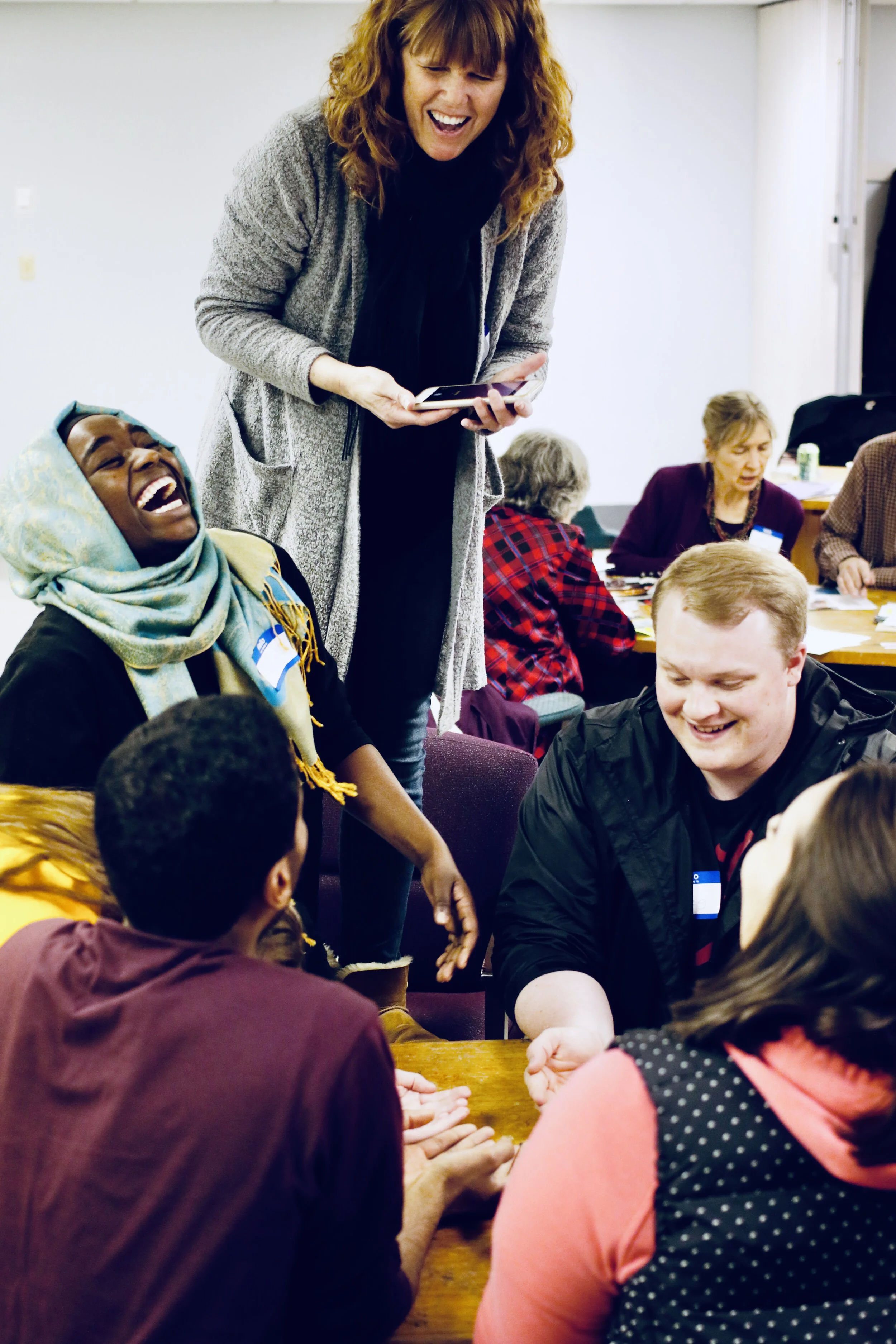Shared Narratives
One of the most striking photographs to come out of our work was composed during the final meeting of our project in Richmond, Virginia. As people worked together in small groups to select pictures for their photovoice exhibition, Michelle decided that a photo she had imagined needed to become a reality:
I’m sitting there on that last day and I’m watching people put up their pictures, and it’s like, “I want it up there . . . it needs to be up there.” So I saw all those kids at the table together. I was like, “They’ll be game.” And then I walked over there [and] I said, “Y’all, this is what I want to do.”
The people she recruited as the subjects of her photograph were all in their early twenties and included both Christians and Muslims. After a brief explanation, as Michelle recalled in an interview, “They knew. They got it. Instantly, they got it. . . . they understood what I was trying to do.”
What was Michelle “trying to do?” What did the people who agreed to pose for the photo “get?” And what was it that they “knew?” To answer these questions is found in what Michelle perceived to be missing from the story of the Richmond photovoice project. Before exploring this gap she saw, it is helpful to be reminded that during the final meeting participants work together to identify themes and photographs for an art exhibition. They sit in mixed Christian-Muslim groups, deliberate over themes, and puzzle over images. As they make selections, they use photos and written descriptions to anchor their photos in their own contents and meanings.
Photo 1. Participants share and discuss their photos in small groups.
After participants complete a selection and mockup, they use painter’s tape (a mild adhesive tape that is easy to remove) to ‘hang’ their composition on the wall. Over the course of the meeting, photographs populate the walls and participants eventually browse the collection, rearrange images into groups by theme, and reason together about which ones should be included in the exhibition. Eventually, the photographer will use the mockup and feedback from deliberations to draft a title and caption for photos selected for exhibition.
Photo 2. Participants work together to group photos into themes and choose the final photos for the exhibition.
Part way through the evening, at an early stage of work being hung on the wall, Michelle perceived an absence, one that she sensed others would also recognize. If willingness to participate, interest in how the photo turned out, and effort exerted in co-creating the title and caption are any gauge of “getting it,” then it would seem that Michelle was correct. These young adults were not passive models for a staged photograph. Instead, they worked collaboratively with the photographer, which meant snapping multiple photographs and repositioning their bodies so that Muslims’ and Christians’ hands alternated. My camera recorded their smiles and laughter as this episode unfolded.
Photo 3. Interactions while composing a photo of their hands were punctuated with laughter.
Once Michelle had a few good photos, the group appeared to be deeply invested in reaching a consensus about which one to use. Israa used our portable photo printer to create a copy of the image that could be posted on the wall. Once on the wall with other images, the hands photo resonated with everyone else in the room even though it was proposed without a title or caption.
Photo 4. Participants had a deep interest in seeing how Michelle’s photo of their hands looked.
Throughout the photovoice project, participants in Richmond made hundreds of photos and told myriad stories about them. Their work uncovered shared beliefs, concerns, and values. The photos that eventually ended up on the wall that night echoed participants’ conversations about how the brokenness of the world challenges their faith, religious and spiritual practices in everyday life, and the internal struggles they face as they wrestle with the teachings of their faith. A few photos included a participant (e.g., “selfies”), but none included fellow participants to represent the experience or outcome of interfaith photovoice. Michelle’s photo made it possible to tell the story behind her experience and the sense of purpose she shared with her collaborators.
Photo 5. Participants taking a photo of their original idea to depict unity.
Even though Richmond participants knew the story behind the photograph—indeed, they were the story of the photo—the picture still needed a title and caption for the exhibition. Just as the photo was a collaboration, so were the words that helped to tell its story to a broader audience. Aptly titled “Unity” the group chose passages from the last sermon of the Prophet Mohammed and the Apostle Paul:
All mankind is from Adam and Eve, an Arab has no superiority over a non-Arab nor a non-Arab has any superiority over an Arab; also a white has no superiority over black nor a black has any superiority over white. (Prophet Muhammad, PBUH)
There is no longer Jew or Greek, there is no longer slave or free, there is no longer male and female; for all of you are one . . . . (The Apostle Paul)
Not only do these passages anchor the image in deeper meanings, they also represent an important discovery. Just as Muslims and Christians could embrace one another and pursue a goal of unity, their teachings also support this possibility. Not only did Israa, Khalil, Fatima, Olivia, Jessica, and Greg understand what Michelle was trying to do, their collective effort offers evidence for what photovoice may accomplish. Six weeks earlier these young adults did not know one another; by the end of the project they made a collective gesture of solidarity.
Activity 12
As you consider your experiences with your conversation partner(s), are there any photographs that might be missing from the collection? What photo would you compose to fill that gap or to describe what you learned through Interfaith Photovoice?





